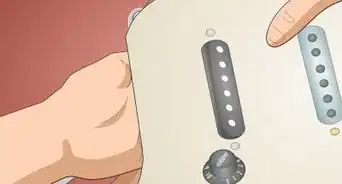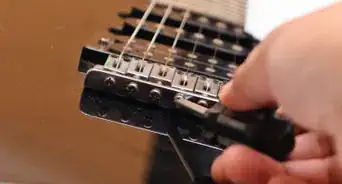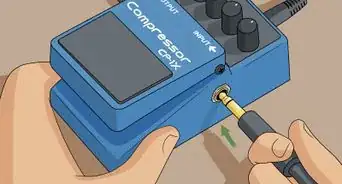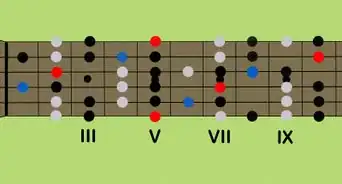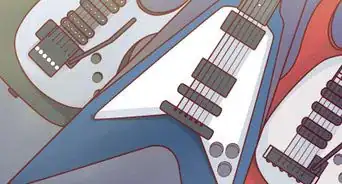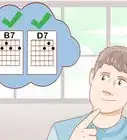This article was co-authored by Aaron Asghari. Aaron Asghari is a Professional Guitarist and the lead guitarist of The Ghost Next Door. He received his degree in Guitar Performance from the Guitar Institute of Technology program in Los Angeles. In addition to writing and performing with The Ghost Next Door, he is the founder and primary guitar instructor of Asghari Guitar Lessons.
There are 9 references cited in this article, which can be found at the bottom of the page.
This article has been viewed 166,568 times.
Playing the electric guitar is a fulfilling hobby that requires time, patience, and dedication to master. Amplifiers are the piece of equipment that allows you to make sound with your electric guitar. While many traditional amps come with two pieces of equipment called the head and cabinet, combo amps have both technologies contained in one easy-to-use piece of equipment.[1] You can either connect your electric guitar directly to your combo amp or connect it through pedals to get different distortions. Both methods are fairly simple and user-friendly to do.
Steps
Connecting Directly to the Amp
-
1Connect the amp's power cord to the wall. Before your amp projects sound, it requires power. First, make sure that your amp's switch is in the off position. Then, take the power cord from the back of your combination amp and plug it into a wall socket. Once it's plugged in, flip the power switch to test if its power is on. On many amps, there will be a red or green light designating that there is power running to your amp.[2]
- If your power cable isn't attached to the back of your amp, you may need to plug it into your amp before plugging it into the wall.
- If your amp doesn't turn on, switch sockets to see if it is a faulty electrical outlet.
- If you don't have a faulty electrical outlet and your amp still doesn't turn on, consider taking it to an instrument repair shop to get it examined.
-
2Plug your guitar cable into your guitar. You can purchase a guitar cable at most music stores. Guitar cables are typically called instrument cables or a 1/4” cable. These cables have a plug that fits into your input jack on your combination amp and is what allows the guitar to play through the amp's speakers. The guitar's jack should be on the front of the guitar or the edge of the guitar and will look like a metallic socket.[3]
- Popular guitar cable brands include Planet Waves American Stage Guitar and Instrument Cable, Monster S100-I-12 Standard 100 1/4-Inch Instrument Cable, and George L's 155 Guage Cable.[4]
- You can also purchase 1/4" instrument cables online.
Advertisement -
3Turn the volume and gain on the amp down. Turning down the volume and the gain will prevent feedback and will stop you from blowing out your speaker when you plug in your guitar.[5]
-
4Plug the other end of the cord into the input jack. Take the other end of your guitar's cable and plug it into the input jack on your amplifier.[6] Your guitar should be directly connected to the combo amp with your instrument cable.
-
5Turn your amp on and turn the volume and gain up. Adjust the volume and gain knobs on your amp until your guitar reaches a suitable volume. You can test the volume of your guitar by strumming an open string as you adjust the knob on your amp.[7]
- You can use the knobs on your instrument to reduce gain and volume as you play instead of having to walk over your amp.
-
6Test other knobs on your combo amp. Test other knobs on the guitar like bass, mid, and treble knobs. Start these knobs off in the 12 o'clock position to give your guitar a default tone. Then, start to adjust the different knobs and play your guitar until it reaches the sound that you desire.[8]
- Your combo amp may already have built-in distortions like overdrive. Test the different features of your amp.
- If your tone isn't thick or full enough, experiment with bringing up your amp's bass knob.
- If your guitar's tone is too muddy or muffled, consider turning down the bass and the mid while turning up the treble.
- All amps are different, so there isn't a particular preset that you can use on all amps.
Hooking Up Guitar Pedals
-
1Get enough guitar cables. When using a guitar pedal, it's necessary that you use more than one 1/4-inch cable. When using more than one pedal, you'll need even more 1/4-inch cables. The cables used to connect your pedals together can be much shorter than the cable you use to connect directly to your amp.[9]
- Cables can be as small as six inches long.
-
2Plug your pedal into a power source or use batteries. Many pedals have replaceable batteries so that you don't have to plug them into an outlet. They also come equipped with an adapter that allows you to plug the pedal directly into the wall. Make sure that the batteries are fully charged on your pedal or that it's hooked up to a power source.
-
3Connect your guitar to a pedal using an instrument cable. Plug the instrument cable into the front or the side of your electric guitar. Then, take the other end of the cable and plug it into the input jack on your guitar pedal.
-
4Plug a guitar cable into the output jack of your pedal. Take another instrument cable and plug it into the output jack on your pedal. If your pedal is on the pedal board, make sure that you have a long enough cord to reach the amp.
-
5Plug the cable from your pedal into the input jack on the amp. Take the cable hanging from the output jack of your pedal and plug the other end into the input jack of your combo amp. This will complete the connection and will allow your guitar's sound to be distorted before it reaches the amp.
Testing the Equipment
-
1Switch your combo amp on. Find the power switch for your combination amp and set it to the on position. Make sure that your amp is plugged into a power source before doing this. Check the gain and volume knobs on both your amp and your pedal before turning your amp on. Make sure that these knobs are all turned down, or you may get feedback when you plug in your guitar.
-
2Test the pedal by turning it on and off. Turn the pedal on and off by pressing down on it with your foot. There should be an indicator light that looks similar to the indicator light on your combination amp.
-
3Chain effects pedals together. When working with multiple pedals, you can connect them together to create various effects. Do this by connecting small instrument cables from the output of one pedal into the input of the next pedal. You can chain pedals like this to create different kinds of sounds, or to have different effects at your fingertips.[10]
- Common pedals include tuner, reverb, overdrive, blues, and loop pedals.[11]
-
4Follow the right framework and order when using multiple pedals. Some rules and techniques when chaining your pedals together can improve the sound. For example, tuner pedals should come first because pedals that alter the tone of your guitar may throw off the tuner. Pedals that amplify noise like overdrive, compressors and wah pedals should go next. Pedals that modify the tone, like chorus and tremolo pedals should go after amplifier pedals, and should be followed by pedals that adjust the guitars ambiance, like reverb or delay pedals.
- Pedals that amplify the tone or volume should go before pedals that adjust or modify the tone, though you can mix this up to get some interesting effects.[12]
Expert Q&A
Did you know you can get expert answers for this article?
Unlock expert answers by supporting wikiHow
-
QuestionHow do I connect a mixer to my amp?
 Aaron AsghariAaron Asghari is a Professional Guitarist and the lead guitarist of The Ghost Next Door. He received his degree in Guitar Performance from the Guitar Institute of Technology program in Los Angeles. In addition to writing and performing with The Ghost Next Door, he is the founder and primary guitar instructor of Asghari Guitar Lessons.
Aaron AsghariAaron Asghari is a Professional Guitarist and the lead guitarist of The Ghost Next Door. He received his degree in Guitar Performance from the Guitar Institute of Technology program in Los Angeles. In addition to writing and performing with The Ghost Next Door, he is the founder and primary guitar instructor of Asghari Guitar Lessons.
Professional Guitarist & Instructor
-
QuestionWhat type of connecter do you prefer to buy for an electric toy guitar?
 Community AnswerIt really depends on which kind of cable the toy guitar uses. Typically guitars need to have a 1/4'' cable in order to properly work in a combo amp.
Community AnswerIt really depends on which kind of cable the toy guitar uses. Typically guitars need to have a 1/4'' cable in order to properly work in a combo amp. -
QuestionHow do I control it if the gain is too loud?
 Community AnswerMost amps have a volume knob, or a volume and gain knob. Generally, "gain" means "distortion," so you can turn the gain knob down and volume up if possible, or just turn the volume down if that's your only choice. If your amp has a boost button, turn that off if you want less volume and/or gain.
Community AnswerMost amps have a volume knob, or a volume and gain knob. Generally, "gain" means "distortion," so you can turn the gain knob down and volume up if possible, or just turn the volume down if that's your only choice. If your amp has a boost button, turn that off if you want less volume and/or gain.
Things You'll Need
- Combo amp
- Guitar
- 1/4-inch instrument cables
- Effects pedal(s) (optional)
References
- ↑ http://www.start-playing-guitar.com/guitar-amplifier.html
- ↑ https://www.ifixit.com/Answers/View/2453/Why+won't+my+Amp+power+up
- ↑ http://equipboard.com/posts/best-guitar-cable
- ↑ http://equipboard.com/posts/best-guitar-cable
- ↑ http://www.dummies.com/art-center/music/guitar/how-to-tune-up-a-new-electric-guitar-amplifier/
- ↑ http://www.start-playing-guitar.com/guitar-amplifier.html
- ↑ http://liveukulele.com/gear/amplifying-your-ukulele/
- ↑ http://guitargearfinder.com/guides/ultimate-guide-to-guitar-amp-settings/
- ↑ http://equipboard.com/posts/best-guitar-cable
About This Article
If you want to connect your electric guitar to your combo amp, all you’ll need is a guitar cable and a power outlet. To get it connected, start by plugging your amp into a power outlet and making sure the switch on the amp is turned off. Plug your guitar cable into the jack, which is a metallic socket that should be on the front or side of your guitar. Make sure the volume and gain are turned down on the amp so you don’t blow out the speaker when you turn it on. Then, plug the other end of the guitar cable into the input jack on the amp. Turn the amp on and slowly turn the volume and gain up until you get a sound you like. To learn how to hook up your combo app through guitar pedals, read more from our Guitarist co-author!

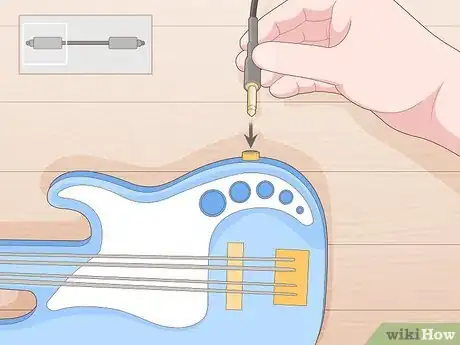

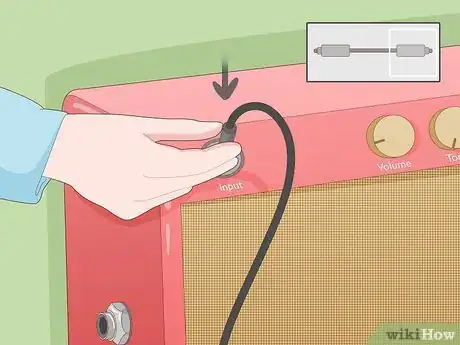


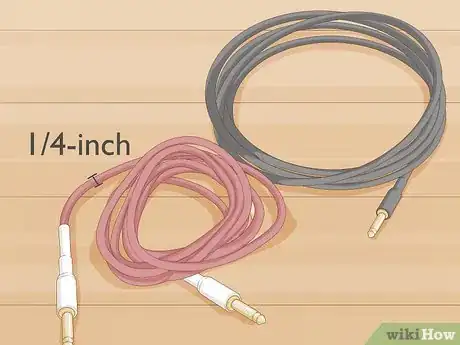
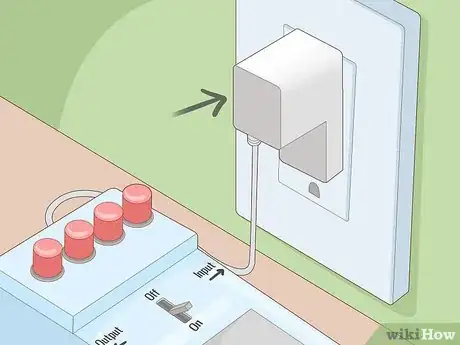
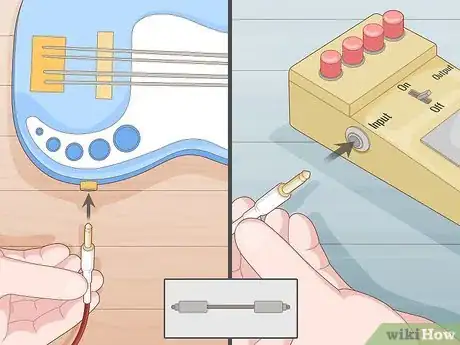
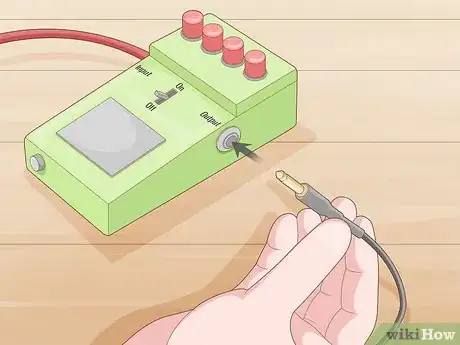
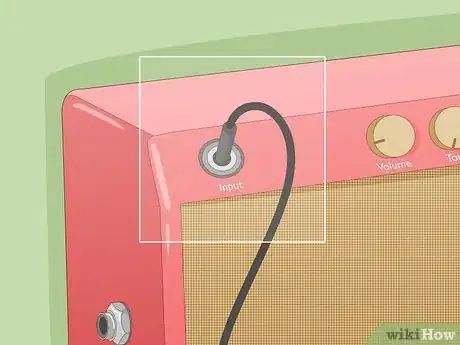
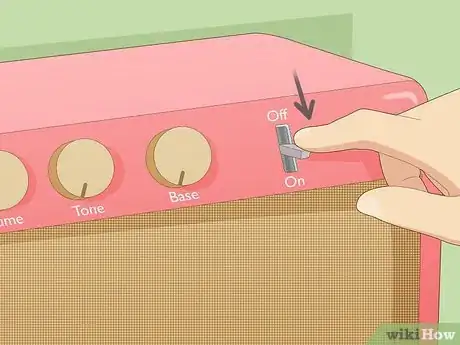

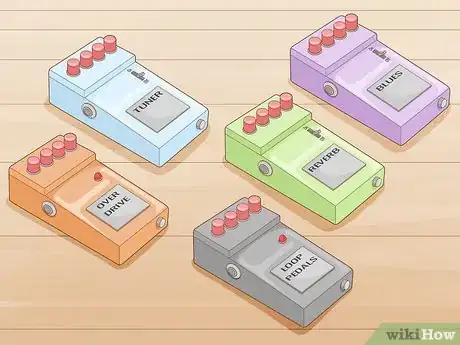
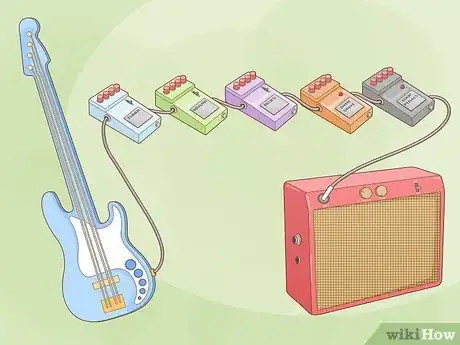
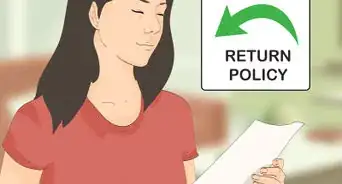

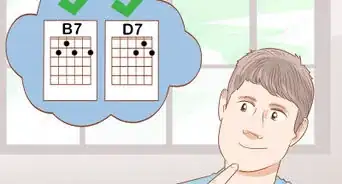
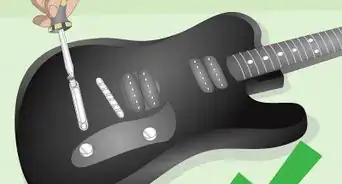
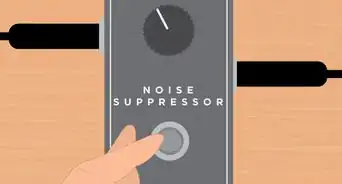

-Step-19-Version-2.webp)
